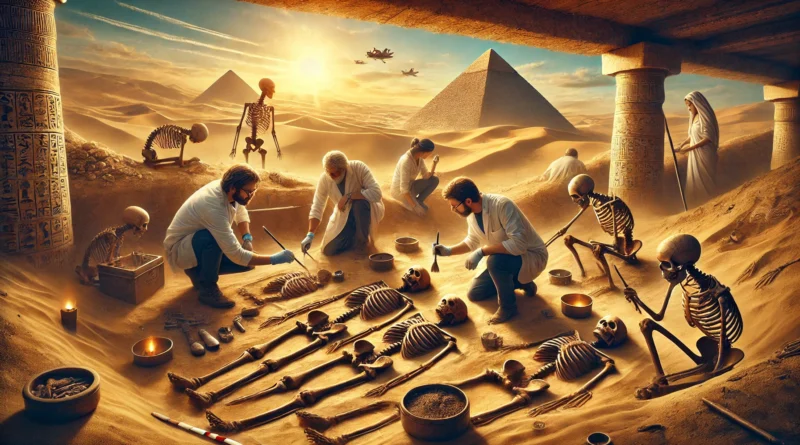Ancient Egypt Skeleton Discoveries: Uncovering the Secrets of a Hidden Past
Recent discoveries in Egypt are rewriting what we know about one of history’s most fascinating civilizations. A team of archaeologists uncovered several ancient skeletons that challenge long-held beliefs about the lives and customs of the people who lived along the Nile thousands of years ago. This breakthrough is sparking new debates among historians and scientists and promises to shed light on ancient Egyptian society in a way that has never been seen before.
For decades, experts have painted a picture of ancient Egyptian life based on well-known monuments, artifacts, and the remains of mummified royals. However, the unearthing of these skeletons reveals that everyday life in ancient Egypt might have been very different. Unlike the careful preservation techniques used for royal mummies, these skeletons were found in more humble settings. They were buried in common cemeteries rather than elaborate tombs, suggesting that they belonged to ordinary people.
The research team believes that the differences in burial practices indicate a more complex social structure than previously assumed. Dr. Ahmed El-Masry, one of the lead archaeologists on the project, explains, “These remains give us a rare glimpse into the lives of people who were not part of the elite. They help us understand the diversity and everyday experiences of ancient Egyptians.” His team is excited because these skeletons could reveal clues about the diets, health, and even the diseases that affected the common population.
One surprising element of the discovery is the evidence of physical labor and injuries seen on many of the skeletons. Some bones show signs of repetitive stress, while others have healed fractures and signs of old injuries. Such findings suggest that many ancient Egyptians worked hard from a young age, often performing physically demanding tasks that shaped their bodies over time. These clues have led scientists to consider that the ancient society might have placed a much higher value on work and practicality than on the elaborate rituals that dominated royal burials.
Additionally, researchers found remnants of tools and everyday objects near the burial sites. These items give context to the lives of these individuals and hint at their daily struggles and successes. For instance, simple tools used for farming and crafting indicate that agriculture played a significant role in their community. The presence of these artifacts helps confirm that these skeletons likely belonged to workers who contributed directly to the building and maintenance of society.
The discovery also offers an opportunity to rethink the role of religion in everyday life. Traditional beliefs have long held that only the elite had special spiritual access to the gods. Yet, these common burials suggest that religious practices might have been more democratic, with even ordinary citizens taking part in rituals meant to secure a good afterlife. Researchers are now looking into whether these individuals were buried with modest personal tokens that held religious significance.
In the coming months, the team plans to conduct further studies using advanced imaging and dating techniques. These methods will help them pinpoint the exact time periods when these individuals lived and determine if they belonged to a specific social group or if their lives overlapped with major historical events. The hope is that these findings will fill gaps in our historical records and provide a more detailed picture of ancient Egyptian society.
Local museums are eagerly awaiting the opportunity to showcase these findings. The new skeletons are not only of scientific interest but also serve as a reminder of the rich cultural heritage that ancient Egypt represents. As the story unfolds, there is excitement about how this evidence might influence both modern archaeological practices and our understanding of history.
Schools and universities are also taking note. Teachers see this discovery as a valuable educational tool that could help students better understand history beyond textbooks. By connecting classroom lessons with real-world archaeological finds, educators believe that students will gain a deeper appreciation for the complexities of past civilizations and the methods used to uncover their secrets.
This breakthrough in ancient Egyptian research is a powerful reminder that history is ever-evolving. What we think we know today might be challenged by the discoveries of tomorrow. With each new find, researchers have the chance to reconstruct the lives of those who lived long before us, providing us with a clearer view of the human experience across the ages.
The excitement surrounding these skeletons is just the beginning. As investigations continue, more questions are expected to arise. How did these ordinary Egyptians live day to day? What challenges did they face? And how did their experiences differ from the well-documented lives of their more famous predecessors? Answers to these questions could redefine our understanding of one of the world’s oldest and most influential civilizations.
In conclusion, the recent skeleton discoveries in Egypt are setting the stage for a new chapter in the study of ancient history. They challenge old assumptions and encourage scholars to look deeper into the past. For now, the world watches with anticipation as history is rewritten one bone at a time.
Note: This post was created with the help of AI, and all the data used was collected from reliable websites.




